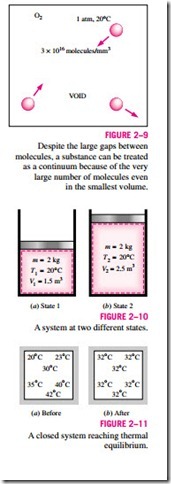STATE AND EQUILIBRIUM
Consider a system not undergoing any change. At this point, all the properties can be measured or calculated throughout the entire system, which gives us a set of properties that completely describes the condition, or the state, of the system. At a given state, all the properties of a system have fixed values. If the value of even one property changes, the state will change to a different one. In Fig. 2–10 a system is shown at two different states.
Thermodynamics deals with equilibrium states. The word equilibrium implies a state of balance. In an equilibrium state there are no unbalanced potentials (or driving forces) within the system. A system in equilibrium experiences no changes when it is isolated from its surroundings.
There are many types of equilibrium, and a system is not in thermodynamic A system at two different states.
equilibrium unless the conditions of all the relevant types of equilibrium are satisfied. For example, a system is in thermal equilibrium if the temperature is the same throughout the entire system, as shown in Fig. 2–11. That is, the system involves no temperature differential, which is the driving force for heat flow. Mechanical equilibrium is related to pressure, and a system is in mechanical equilibrium if there is no change in pressure at any point of the system with time. However, the pressure may vary within the system with elevation as a result of gravitational effects. However, the higher pressure at a bottom layer is balanced by the extra weight it must carry, and, therefore, there is no imbalance of forces. The variation of pressure as a result of gravity in most thermodynamic systems is relatively small and usually disregarded. If a system involves two phases, it is in phase equilibrium when the mass of each phase reaches an equilibrium level and stays there. Finally, a system is in chemical equilibrium if its chemical composition does not change with time, that is, no chemical reactions occur. A system will not be in equilibrium unless all the relevant equilibrium criteria are satisfied.
The State Postulate
As noted earlier, the state of a system is described by its properties. But we know from experience that we do not need to specify all the properties in order to fix a state. Once a sufficient number of properties are specified, the rest of the properties assume certain values automatically. That is, specifying a certain number of properties is sufficient to fix a state. The number of properties required to fix the state of a system is given by the state postulate:
The state of a simple compressible system is completely specified by two independent, intensive properties.
A system is called a simple compressible system in the absence of electrical, magnetic, gravitational, motion, and surface tension effects. These effects are due to external force fields and are negligible for most engineering problems. Otherwise, an additional property needs to be specified for each effect that is significant. If the gravitational effects are to be considered, for example, the elevation z needs to be specified in addition to the two properties necessary to fix the state.
The state postulate requires that the two properties specified be independent to fix the state. Two properties are independent if one property can be varied while the other one is held constant. Temperature and specific volume, for ex- ample, are always independent properties, and together they can fix the state of a simple compressible system (Fig. 2–12). Temperature and pressure, how- ever, are independent properties for single-phase systems, but are dependent properties for multiphase systems. At sea level (P = 1 atm), water boils at 100°C, but on a mountaintop where the pressure is lower, water boils at a lower temperature. That is, T = f (P) during a phase-change process; thus, temperature and pressure are not sufficient to fix the state of a two-phase sys- tem. Phase-change processes are discussed in detail in Chap. 3.
